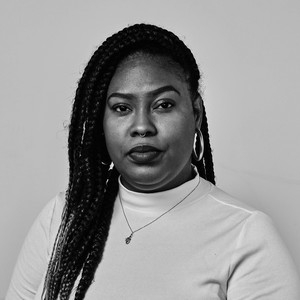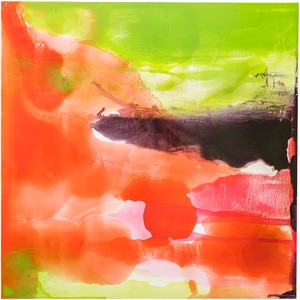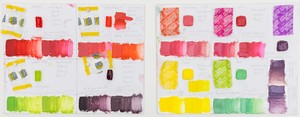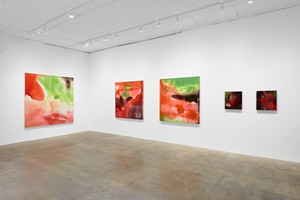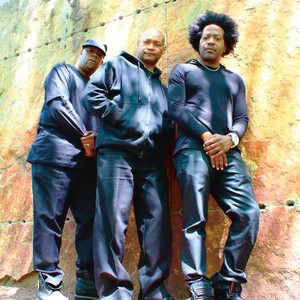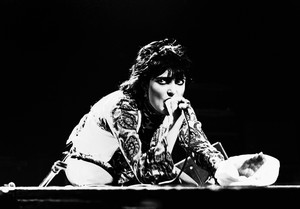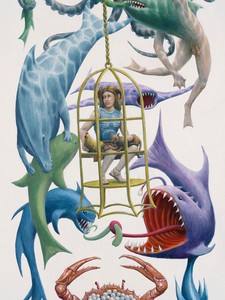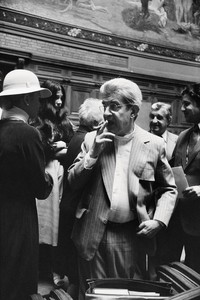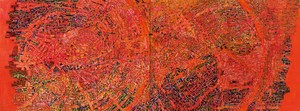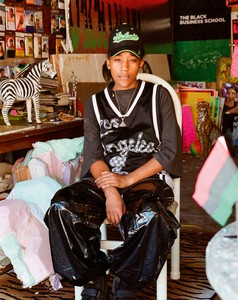The informal economy sustains. Beyond the constraints of state bureaucracy, streams of income—untaxed, in theory unlimited—flow where needed and required, a self-regulating network feeding, housing, and clothing millions. There are, by design, no advertisements, no backing; word of mouth and ad hoc business acumen is the requisite modus. These enterprises exist within the universe of the elote stands, ice cream trucks, and snowball carts dotting each enclave, unique in their situation within the home. Among this class of entrepreneurs, the gendered order is evident: female vulnerability and socialization dictate, as they do everything. A life or livelihood outdoors has always been safer and more available to men. Among the throngs of enterprising entrepreneurial masses in Black enclaves are women who sell candy and other small goods out of their homes. These women are the subject and source of Amanda Williams’s solo show, her third, at Gagosian, New York, titled CANDYLADYBLACK, a continued meditation in color. Williams approaches and, in her own way, depicts the candy ladies and their consumers in her standard manner, mingling serious intellectual consideration of Black subjects with bright, fresh whimsy, capturing them at their most essential.
Williams is a Cornell-trained architect and a Chicago native. Through her paintings, works on paper, and sculptures, she has managed to commingle these identities, conceptualizing fresh approaches to what has often been dismissed as unworthy of critical or artistic engagement: the makeshift artworks and labor of the working class, Black, female, and informal artists and artistry that exist outside of formal institutions and recognitions. She has work in the collections of New York’s Museum of Modern Art, the Art Institute of Chicago, and elsewhere, and has a permanent monument to Shirley Chisholm, the first Black congresswoman in US history, underway in Brooklyn’s Prospect Park, all while serving on the design team for the Obama presidential library in Chicago. Williams repeatedly returns to questions of how space, commercial interests, value, and urbanity intersect with—and antagonize—Black existence. In the series What Black Is This, You Say? (2020–), for example, she provides a cheeky critique of Blackout Tuesday, a viral movement in which Instagram users posted black squares on the application’s pages after police violence in the summer of 2020. Her most praised and provocative project so far, Color(ed) Theory (2014–16), debuted at the Chicago Architecture Biennial in 2015: over two years, assisted by her loved ones, Williams repainted eight empty condemned houses in Englewood, Chicago, each in a different, vibrant hue. The colors of the houses were unignorable, inviting examination and jutting out amid otherwise colorless expanses: the slate gray of winter skies, the slushy colors of long untended yards and lots ubiquitous within neglected neighborhoods. Her palette evoked the commodities central to the culture of the city’s South Side: the ubiquitous, staining scarlet of Cheetos, the varied tones of the signature chicken shacks, the regal velvet of Crown Royal bags and personal styling products. Facing what had been dismissed, labeled “condemned,” Williams countered “Why?” and “According to whom?” She emphasized each home’s singularity, reminding us that the delineations between detritus and sculptural wonders are innately racialized, a matter of subjectivity. “When you grow up in a segregated city as I have, like Chicago, you’re conditioned to believe that color and race can never be separated,” she has said. “Racism is my city’s vivid hue.” The logics of architecture and of race converge.
Williams’s new exhibition is a return to old fixations, not only conversant with prior works but an impressive, lively expansion of them. Having established her topics—the city of her birth, modernity, urban blight, Black expressivity, architecture as racial implement—she now bounds beyond previously drawn borders. Where the architect had previously concerned herself with exteriors, CANDYLADYBLACK, an expansion of What Black Is This, You Say? peeks inside at some of their potential denizens, equally spectral and systematically disappeared. The Black grandmother, an eponymous, seldom portrayed figure, is all too familiar: those stalwart, unbowed matriarchs, doling out candy hidden in purses and pockets, saccharine in their own right, and typically more object than subject. Here she is revealed as a hustler type, a character with whom we are less familiar. The name also inevitably brings to mind its obverse, the candyman, a more malevolent but equally well-known character.
Sugar was a commodified good of the slave economy, the basis of untold fortunes. Here it is reclaimed by those who have not been the beneficiaries of that system. The selling of goods out of the home blurs and does away with distinctions between public and private, work and pleasure, the sorts of delineations that Williams has repeatedly refuted. CANDYLADYBLACK opposes orderliness, unerring boundaries, and established boundaries, welcoming a messier chromatic seepage. The tone of the pieces is a reenactment of chaos, melding the random and the ordered. What might the architect’s eye make of the absence of lines and symmetry, principal concepts of her training? In this way she seems to refuse the brutal, colorless architecture of the contemporary realm. In this series Williams utilizes nine evocative tones mimicking the artificial, chemically brightened hues of beloved sugar treats. The paintings are delightfully, unnaturally saturated, alluding to the dextrose, sucrose, preservatives, and chemical dyes that constitute popular candies. The greens are iridescent, the color not of actual limes but of lime-flavored gummies, Frooties, Pixy Stix, bubble gum, and chews. Some of these hues traipse at the edge of repellent, a near Day-Glo. They drip and run nearly off the canvas, their formations suggesting the little fingerprints of children and the candy women. These are less colors than flavors, pooling and melting into shapes with lives and tales of their own. They have about them the air of an event, some antic occasioning the parade of pigment, and not only a dazzling sunset brightness but a reminder of the brief wonder of Chicago winters. The viewer is drawn in and invited to match each particular color to her own memory, her own favorite sweet. In this way the paintings recall the Rorschach inkblot tests, challenging each imagination to work of its own volition.
The stickiness of the paintings is atmospheric, enveloping. Williams has provided an alternative color experience that manages to both subvert and submerge, almost haptic in the sensations it induces. There has been much proselytizing regarding recent transformations of childhood: we lament the absence of outdoor play, the stringent, intricate diets, the overall loss of a certain sort of citified infancy. Williams’s retrospective is ruminative, playful, nostalgic, although not chastising or overprecious, considered but not overwrought. She recalls the play, the whimsy, of preadult life by envisioning it and inviting the viewer into her colored world. Slip into that bold magenta, that invigorating orpiment, that seductive puce and shocking pink, and recall the wonders of yore, Williams the chromophile is our guide. Viewing the paintings, I am reminded of Alice’s slip down the rabbit hole, how invigorating it is to be allowed entry into a realm of the artist’s making.
It is a realm increasingly sparse. Chicago’s housing projects have largely been demolished. Summer, once relished for its brevity and singular relief, has now, with climate catastrophe, been extended, as autumn and spring grow warmer. Childhood, like summer, passes too soon. Poor and working-class Black neighborhoods are increasingly imperiled, their homes and landscapes reshaped, their people moved and relocated. Gentrified modernist homes are put up in their stead, both the designs and the populations usually absent of color. Williams’s work and mind remain Colored, almost flagrantly so, urging the culture toward her. In its excesses, the work is also a critique of the austerity of government programs in the face of systemic poverty, of lives governed by having just enough to survive. The world Williams allows is predicated on succor and vibrancy. Her works are equal parts parade, memorial, tribute, and mourning ritual.
Black artists have always responded to the ills of the time—police brutality, white supremacy, xenophobia, homophobia—through their creative practices. In the wake of the summer of 2020, what was initially a turn toward the political side of Black art has instead grown into a demand. The artist must express her politics and they must be legible and digestible to the masses. Black artists are rarely presumed to be technically astute stylists or abstractionists. Through this series, Williams manages a narrative without bodies or language, producing an alternative mode of figuration. It is nothing as flat or simplistic as joy that she is relaying, but rather the entire spectrum of Black experience, our youths, homes, lives, elders—here and not. It is as if Williams had looked about, taken stock of the colors and options available, and found them insufficient. With CANDYLADYBLACK she has conceptualized new hues, new spectrums of thought and feeling, and a more dimensional Black collectivity.


